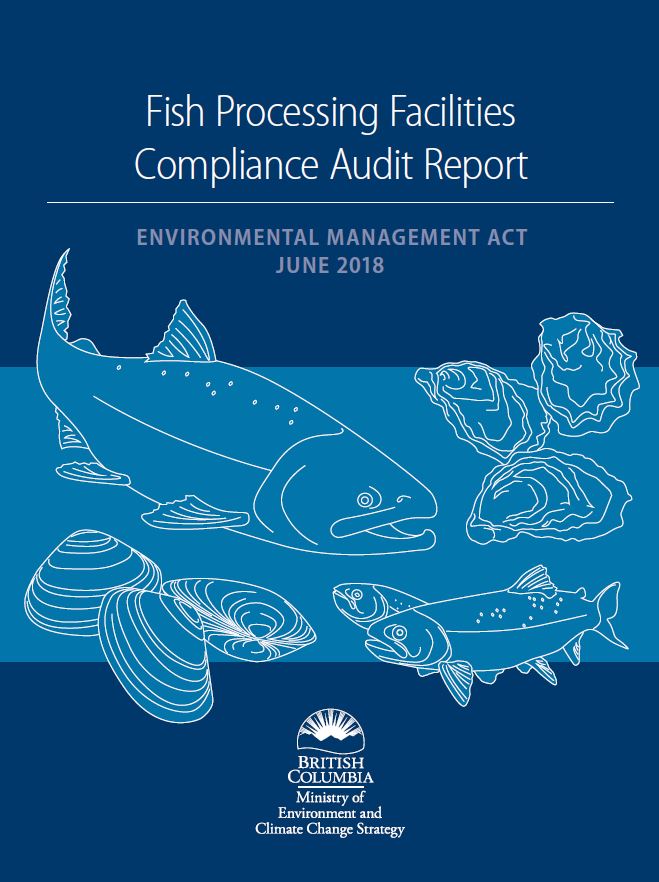Fish Processing Plant Sector Compliance Audit
June 2018
The Ministry of Environment and Climate Change Strategy (ENV) has conducted an audit of the current effluent discharge authorizations under the Environmental Management Act (EMA) within the fish processing industry in British Columbia.
The objectives of the audit were to:
- Conduct inspections to verify compliance under the regulatory requirements established in their authorizations;
- Collect effluent samples to assess the characteristics of the effluent and determine whether the effluent is potentially causing pollution;
- Assess whether the authorizations contain consistent foundational environmental protection provisions; and
- Identify the best achievable technology (BAT) for the treatment of effluent.
Inspections were conducted for all 30 fish processing facilities authorized under EMA in B.C. A total of 202 requirements were assessed for compliance within the 30 permits. Of the 202 permit requirements, the fish processing facilities were In Compliance with 44 percent of the requirements, Out of Compliance with 22 percent of the requirements and compliance was Not Determined for 10 percent of the requirements and Not Applicable for 24 percent of the requirements.
In most cases, the instances of non-compliance were administrative in nature; however, the facilities were also found to be Out of Compliance for exceeding the discharge rate and the discharge quality. In some instances, the facilities were not conducting the required monitoring or reporting. The effluent discharge quality and toxicity results indicate that undiluted fish processing facility effluent can be acutely lethal to fish.
Most of the EMA permits do not contain the foundational requirements that are necessary to be protective of the environment. Some differences are expected due to the site-specific nature of permitting; however, the permits frequently do not contain effluent discharge quality limits and monitoring and reporting requirements for discharge rate, discharge quality and receiving environment quality. It is recommended that the existing permits be amended to include these foundational environmental protection provisions.
Best achievable technology (BAT) for the sector includes preliminary treatment (solids removal), primary treatment (suspended solids removal), and disinfection where required to control the spread of fish pathogens. BAT for facilities operating continuously for more than six months of the year also may include secondary treatment (soluble biological oxygen demand (BOD) reduction). Most of the current permits authorize and require only preliminary treatment using fine screening. Two of the 30 permits additionally require primary treatment as well as disinfection. BAT should be considered in the determination of effluent discharge limits when amending these permits. Many of the permittees indicated that the costs associated with additional treatment would be too much of a burden on their current budgets and they would have to discontinue the operation of their facilities if additional treatment is required.
Recommendations
- The existing permits be amended to include foundational environmental protection provisions such as:
- Numerical values for effluent discharge quality,
- in particular BOD, Chemical Oxygen Demand (COD), Total Suspended Solids (TSS) and nutrients. ENV should engage with Fisheries and Oceans Canada, and Environment and Climate Change Canada to ensure that these values consider existing legislation, such as the Fisheries Act, to ensure that the effluent discharge quality limits do not cause serious harm to fish and the effluent would not be considered a deleterious substance;
- Monitoring for effluent discharge quality and toxicity;
- A well-designed receiving environment monitoring program; and
- An interpretation of the receiving environment data and an assessment of the impact of the discharge on the environment.
- The existing permits be amended to include consistent and verifiable requirements for all permits to the extent possible without limiting the site-specific nature of permitting. Wherever there is a limit or rate, there must be requirements to monitor and report. Wherever there is an authorized works, there must be requirements to maintain the works and to not bypass the works or modify the works without notifying ENV.
- The amending of the existing permits should prioritize facilities based on relative environmental risk, the existing treatment technologies, the tonnage of fish processed and the volume of effluent being discharged.
Inspection Reports & Data
- View Inspection Reports & Data for the Fish Processing Plant Compliance Audit.
Read the Report
Permit Amendment Project
Related Links
Contact information
Environmental Protection Division - Compliance Section

